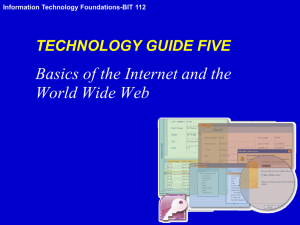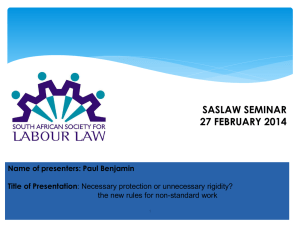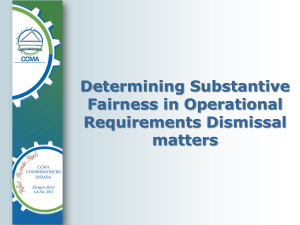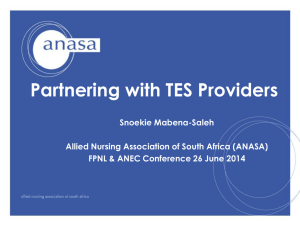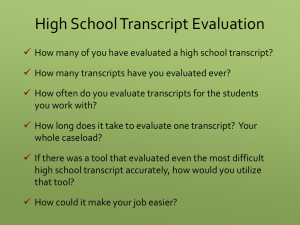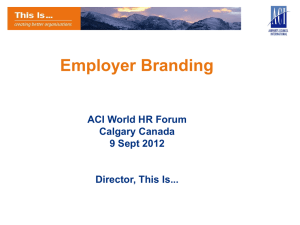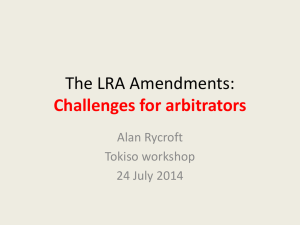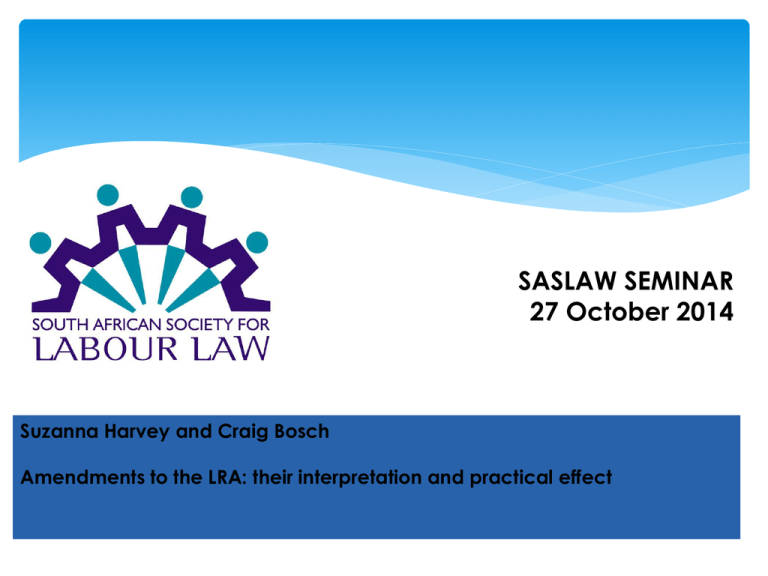
SASLAW SEMINAR
27 October 2014
Suzanna Harvey and Craig Bosch
Amendments to the LRA: their interpretation and practical effect
Style
Hosting a discussion
(towards harnessing our
collective curiosity)
Author and Date
Chapter IX of Act 66 of 1995:
REGULATION OF NON-STANDARD
EMPLOYMENT AND GENERAL
PROVISIONS
THE NEW SECTION 198
Author and Date
Strong views
Cosatu
“Our position on labour [broking] is that it treats workers as
commodities, who can be traded to generate a profit. That is
why we make no apology for calling it human trafficking and a
modern form of slavery."
DA
“Cosatu’s call for a total ban on labour brokers is a clear sign of
an organisation that is delusional to its core ... the country
would actually come to a standstill if labour brokers were
banned.”
Value of Employment Security
Non-standard employment arrangements limit employment
security
Employment security a core purpose of the LRA and s23 of
the Constitution: Nehawu v UCT & Others 2003 (3) SA 1 (CC)
5
Old s198 of the LRA
Labour broker employees
Arbitrary dismissals – often at instance of clients
Nape v INTCS Corporate Solutions (Pty) Ltd (2010) 31 ILJ 2120 (LC)
Dyokhwe v de Kock NO and others (2012) 33 ILJ 2401 (LC)
Primary remedy of reinstatement not available
SA workers vulnerable:
lack accumulated resources/savings
often responsible for entire extended families
ILO’s Decent Work Agenda
LRAA Strikes the Balance
Employers’ genuine, objective need for efficiency
requires reasonable flexibility
Workers need jobs AND protection from
opportunistic rights violations leading to insecurity
LRAA protects
low earners
working > 3 months
Mainly by requiring objective justification for
temporary, fixed term or part-time work
Author and Date
Old
s198
Employee earns
≤ R205 433.30 pa
(~ R 17k pm)
new s4A
s198A
s198D
Labour
Broker
Workers
J/d to
interpret &
apply A-C
LRAA Ch 9
Regulation of
Non-Standard
Employment
s198B
s198C
FTCWS
Part
Timers
8
SECTION 198 PROTECTS ALL LABOUR
BROKER WORKERS
Section 198
All labour broker workers
9
Section 198 – mainly unchanged
(1) A TES: any person who, for reward, procures for or
provides to a client other persons
a) who perform work for the client; and
b) who are remunerated by the TES.
(2) For the purposes of this Act, a person whose services
have been procured for or provided to a client by a TES
is the employee of that TES, and the TES is that
person’s employer
Author and Date
S198 changes to joint liability
Old 198(4) joint and several liability if the TES contravenes a CA,
arbitration award, BCEA or SD regulating terms and
conditions of employment.
New s198(4)A: If Client and TES are jointly/severally liable or
Client is deemed e/r, then
a labour inspector may enforce compliance
an employee may institute proceedings
an order or award made be enforced
against either or both
Author and Date
Section 198
New protections in ss4A-4F
TESs must comply with regulated employment conditions in
the CLIENT’s industry
An arbitrator or the LC may determine whether provisions in
TES-Client contracts, as well as in employment contracts,
comply with SD/CA – and make an appropriate order
12
SECTION 198A
LOW PAID LABOUR BROKER
WORKERS
Protects low-earning labour broker workers
No exclusion for small employers
If they started before the LRAA commenced, ss3-5
apply after 3 months
13
Section 198A
‘Temporary Service’ Defined
New definition of a Temporary Service (TS):
lasts less than 3 months OR
replacing absent employee OR
a category of work which is a defined TS in a
Ministerial Notice, SD or CA
Distinguish a Temporary Employment Service
from a Temporary Service
14
s198A (3)
Restricts employment through labour brokers to genuinely
temporary work.
“ For the purposes of this Act, an employee
(a) performing a TS .. for the client is the employee of the TES
in terms of s198(2); or
(b) not performing such TS for the client is(i)
deemed to be the employee of that client and the client is
deemed to be the employer; and
(ii) subject to the provisions of s198B, employed on an
indefinite basis by the client.”
15
Effect of s198A(3) deeming
When the TES’s client is deemed to be the worker’s employer:
Query
Does the contract of employment transfer to the client,
terminating the employment relationship between the worker
and the TES?
Are there perhaps still two employers? IF SO what are the
implications? Organisational rights, strikes, dismissals,
administration of leave, salary, benefits, s189 consultations,
s197 transfers
Client becomes the duty-bearer (of duties/remedies assigned
to employer under LRA – not affected
by TES continuing admin
16
function.
E/e placed by TES at client
Who is the employer?
Does e/e earn above threshold?
Yes
No
s198
applies
TES is e/r
Both ss 198 and 198A
apply
Is it a TS?
(Client has
limited j/s
liability)
Yes
TES is
e/r
17
No
Client is
e/r
Section 198A
Consequences when client ‘deemed’
The audi principle may require CCMA/BC/Commissioners to
consider joining the client mero motu at an early stage.
If client is the deemed employer, the worker must be
Considered to be employed indefinitely (unless a valid FTC –
see s198B) – implications for remedy if dismissed
treated on the whole not less favourably than the client’s
comparable workers (unless justifiable reasons s198D)
18
Section 198A (4)
Termination to avoid deeming
If the worker’s services for the client are terminated (at the
instance of the client or the TES) in order to avoid deeming, this
is a dismissal.
Query: If the TES removes the worker from the client and
places her elsewhere in order to avoid her being deemed the
client’s employee:
is she nevertheless dismissed whilst continuing to be
employed, and entitled to a remedy if the dismissal was unfair?
19
what might an appropriate remedy
be?
SECTION 198B
FIXED TERM CONTRACT WORKERS
20
Section 198B (2)
Exclusions
s198B in its entirety does NOT apply if:
Employee earns above threshold
Employer is small/new (less than 2 years unless
formed by division/dissolution)
Overridden by CA ‘permitting’ (regulating?) FTCs
‘permitting’ is ambiguous - FTCs already permitted - memo
suggests it means permitting unregulated FTCs longer than 3m
21
Section 198B
FTC defined as one that terminates on
the occurrence of specified event
the completion of specified task or project
a fixed date other than retirement age
Offers must be in writing and state the reason for fixing the term
S186(b) extends dismissal definition to include reasonable
expectation of renewal or indefinite retention
All FTCWs to have equal opportunity to apply for vacancies
Fixed term contract work lasting > 3m
requires an objective justification for fixing the term, and
treat FTCWs no less favourably than permanent employee
‘end of term payment’ if specified
project lasts >2years
22
Section 198B (4)
Justifiable reasons for fixing contract term
Non- exhaustive list of justifiable reasons for fixing the term :
a) Replace absent employee;
b) temporary increase in work, not longer than 12 months;
c) student to gain experience;
d) specified limited-duration project;
e) non-citizen with work permit;
f) seasonal work;
g) official public works or job creation scheme;
h) Project with limited external funding; and
i) beyond retirement age.
23
Section 198B
where requirements not met
FTC >3m without objective justification, the contract of
employment is deemed to be of indefinite duration
the provision fixing the term in the contract is statutorily invalid
(LRA overrides the contract, despite intention of the parties)
If unfairly dismissed, the employee may be reinstated into
indefinite employment OR awarded compensation up to 12
months (regardless of the remaining term of the contract)
If the reason for dismissal was operational, s189 applies
Employer bears onus to show that
the reason for fixing the term was objectively justified; and that
the term was agreed upon
24
SECTION 198C
LOW EARNING PART TIMERS
25
Sections 198C (1) & (2)
Definition, application &
interpretation
Definition: part-timer works fewer hours than comparable fulltimer (a factual enquiry)
Application: This section protects workers who:
work less than full-timers, but more than 24hours per month
are low earners
work for large employers
have worked for more than 3 months
Interpretation: with reference to ILO Convention 175 (facilitate
access to productive and freely-chosen part-time work which meets
the needs of employers and workers)
26
Section 198C (3)
Treatment of part-timers
Protected part-timers are entitled to:
on the whole not less favourable
treatment (unless justifiable reasons for different treatment);
access to training and skills development
&
the same
access to opportunities to apply for vacancies.
27
Section 198C
Remedies?
Prospective relief
Damages
28
SECTION 198D
GENERAL PROVISIONS
29
Section 198D
Overview
Deals with two matters:
1.
Justifiable reasons for different treatment of:
Deemed TES employees
FTCWs who work for over 3 months
Part-timers
2. Disputes over interpretation and application of
sections 198A, B and C.
30
Section 198D (2)
Justifiable Reasons
Justifiable reasons for treating persons differently include
applying a system that takes into account:
• seniority, experience, length of service;
• merit;
• quality or quantity of work; or
• other similar criteria (not prohibited under EEA)
What is a system?
Consistent/Objective
Policy? Custom? Communicated?
31
Section 198D
Dispute Procedure
CCMA and BCs with jurisdiction empowered to interpret and
apply sections 198A-C
(this excludes dismissals, to be dealt with in usual manner)
Dispute Procedure:
Refer within 6 months of act/omission
Conciliation (no time specified)
Refer for Arbitration within 90 days of failed conciliation
32
Strong views
Free Market Foundation
“Some voices in the government alliance have called
for the total abolition of labour brokers. Or lately, for
a regime where the client of a labour broker is
deemed to be the employer, burdened with all the
labour-law obligations that that entails. These calls on
the part of the trade unions, are not only self-serving,
but will lead SA to greater unemployment.”
Thank you
Author and Date
Collective Bargaining
s21(8): in determining whether a registered union is
sufficiently representative a commissioner must also
consider the composition of the work-force in the
workplace taking into account the extent to which
there are employees assigned to work by temporary
employment services, employees employed on fixed
term contracts, part-time employees or employees in
other categories of non-standard employment
Implication?
Author and Date
Collective Bargaining
s22(8A) and (8B): most representative, sufficiently
representative union entitled to rights in s14 if no
other union has been granted that right
Most representative, sufficiently representative union
entitled to rights in s14 may also be granted the rights
contained in s16 provided no other union has been
granted that right
These rights are forfeit as soon as the union is no
longer the most representative
Author and Date
Collective Bargaining
Retreating from majoritarianism (s21(8C)):
Subject to subsection (8), a registered trade union/s
that does not meet thresholds of representativeness
established by a collective agreement in terms of
section 18 may be granted the rights in s12, 13 and 15 if
it represents a significant interest, or a substantial
number of employees in the workplace.
What does this mean and what of the tension with
s21(8)?
Author and Date
Collective Bargaining
s21(12): trade union seeking to exercise organisational
rights in respect of TES employees may seek to do so
in a workplace of either the TES or one or more clients
of the TES.
To that end: An arbitration award granting
organisational rights may be made binding on the
employer and a client of the TES for whom an
employee covered by the award is assigned to work if
given an opportunity to participate in the arbitration
proceedings.
Author and Date
Collective Bargaining
s65(1)(c) no protected strike if the issue in dispute is
one that a party has the right to refer to arbitration or
to the Labour Court in terms of the LRA or any other
employment law
s70D(1), s72 and s73: Essential services committee
may determine the minimum services required to be
maintained in the service that is designated as an
essential service.
Author and Date
Dispute Resolution
Getting finality faster:
s143: A certified arbitration award may be enforced as
if it were an order of the Labour Court in respect of
which a writ has been issued
If a party fails to comply with a certified arbitration
award that orders the performance of an act, other
than the payment of an amount of money it may be
enforced by way of contempt proceedings instituted
in the Labour Court.
Author and Date
Dispute Resolution
s143: An arbitration award in terms of which a party is
required to pay an amount of money must be treated
for the purpose of enforcing or executing that award
as if it were an order of the Magistrate’s Court.
s145: Applicant for review must apply for a date for
the matter to be heard within six months of delivery
of the application
Operation of award not suspended unless security
furnished in terms of s145(8)
Author and Date
Dispute Resolution
Application to set aside an arbitration award in terms
of s145 interrupts the running of prescription in terms
of the Prescription Act in respect of that award.
Judgment in an application brought under s145 must
be handed down as soon as reasonably possible.
LC may not review any decision or ruling made during
conciliation or arbitration proceedings before the
issue in dispute has been finally determined, unless
just and equitable to review before conclusion
Author and Date
Dismissal
s187(1)(c) a dismissal is automatically unfair is the
reason for the dismissal is a refusal by employees to
accept a demand in respect of any matter of mutual
interest between them and their employer
An employee may go to arbitration regarding an
allegedly unfair retrenchment if:
the employer followed a consultation procedure that
applied to that employee only
the employer’s operational requirements lead to the
dismissal of that employee only; or
the employer employs less than ten employees,
irrespective of the number of employees who are
Author and Date
dismissed.
Employment Equity Act
s6(1) No person may unfairly discriminate, directly or
indirectly, against an employee, in any employment
policy or practice, on one or more grounds, including
race, gender, sex, pregnancy, marital status, family
responsibility, ethnic or social origin, colour, sexual
orientation, age, disability, religion, HIV status,
conscience, belief, political opinion, culture, language,
[and] birth or on any other arbitrary ground.
44
Employment Equity Act
Burden of proof
11. (1) If unfair discrimination is alleged on a ground
listed in section 6(1), the employer against whom the
allegation is made must prove, on a balance of
probabilities, that such discrimination—
(a) did not take place as alleged; or
(b) is rational and not unfair, or is otherwise justifiable.
Author and Date
Employment Equity Act
(2) If unfair discrimination is alleged on an arbitrary
ground, the complainant must prove, on a balance of
probabilities, that—
(a) the conduct complained of is not rational;
(b) the conduct complained of amounts to
discrimination; and
(c) the discrimination is unfair.
Author and Date
‘Arbitrary ground’
Suggest that this be taken to refer to analogous
grounds – test based on impact on employee’s dignity
See New Way Motor & Diesel Engineering (Pty) Ltd v
Marsland (JA 15/2007) [2009] ZALAC 27 (13 August
2009) – applying s187(1)(f)
Contra du Toit ‘Protection against Unfair
Discrimination: Cleaning up the Act?’ (2014) 35 ILJ
2623
Author and Date
Equal pay for work of equal value
s6(4) A difference in terms and conditions of
employment between employees of the same employer
performing the same or substantially the same work or
work of equal value that is directly or indirectly based
on any one or more of the grounds listed in subsection
(1), is unfair discrimination.
= nothing new here
Author and Date
Employment Equity Act
S10(6)(aA):
Disputes relating to sexual harassment to conciliation
and then arbitration by the CCMA
All other discrimination disputes to CCMA arbitration
if the applicant earns less than the prescribed
threshold.
S10(8) – awards issued in terms of 10(6)(aA) may be
appealed to the LC within 14 days
Author and Date
Some issues to consider
What is the practical effect of deeming the client to be the
employer of a labour broker worker?
Can a worker be dismissed (to avoid deeming, attracting a
remedy) whilst remaining employed (at a different client)?
What effect will changing TESs have on union representivity?
Will the amendments relating to dispute resolution reduce the
number of review applications?
When is a dismissal contrary to s187(1)(c) as opposed to being
for operational reasons?
What is the effect of the changes to s6 and s11 of the EEA?
Author and Date


